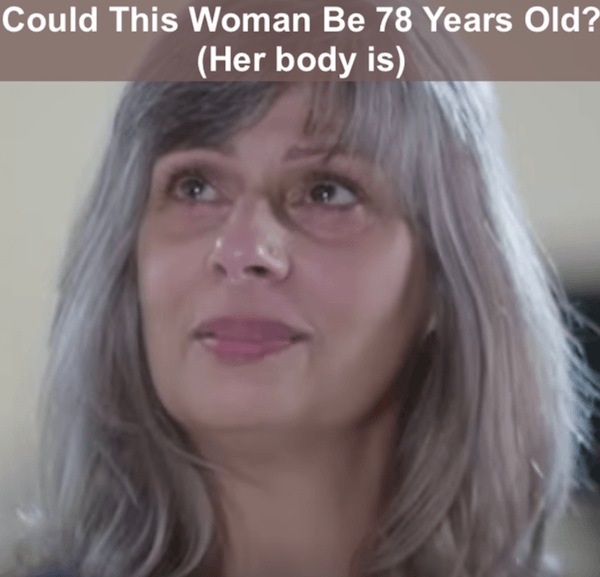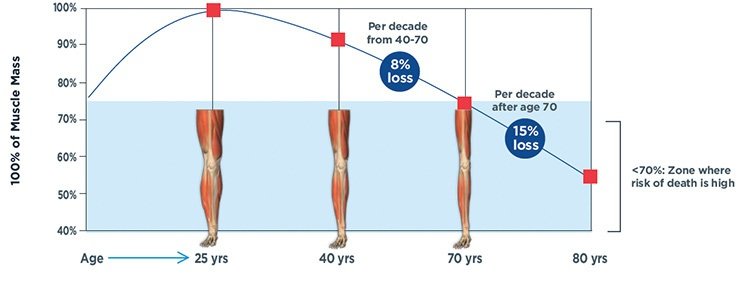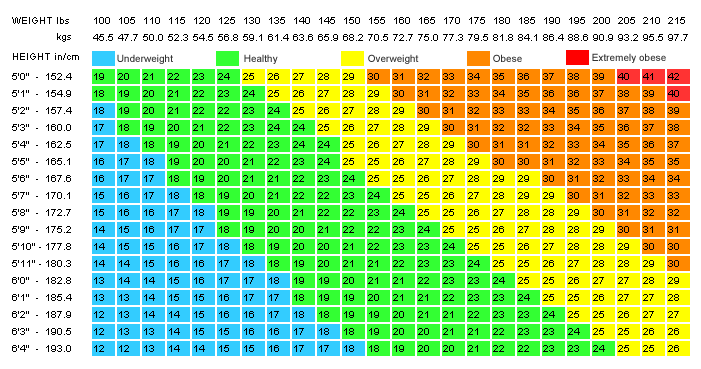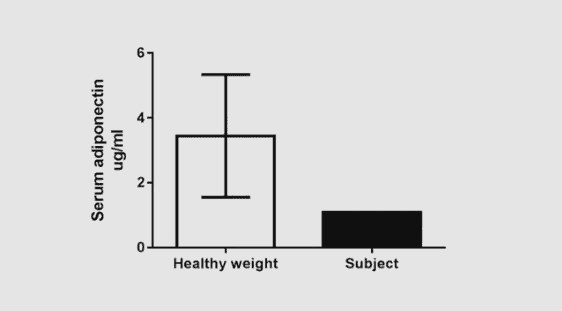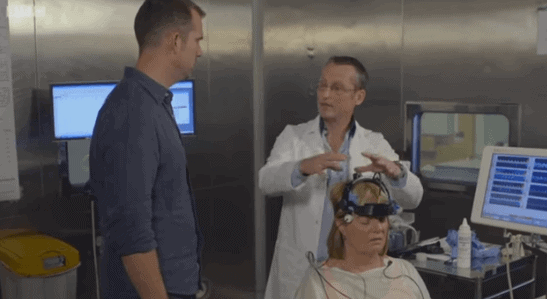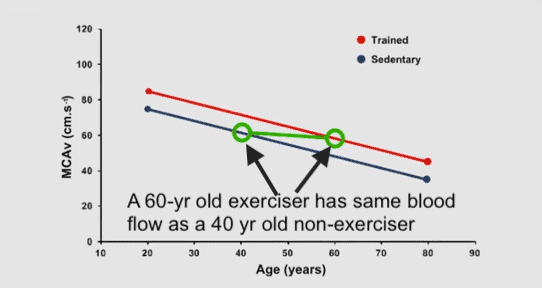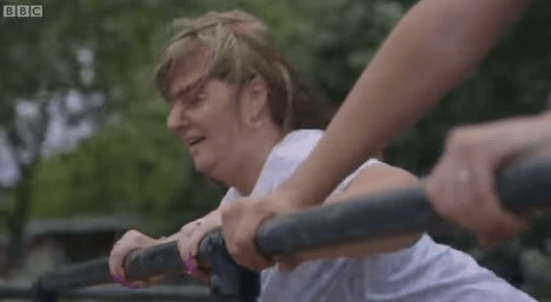How You Can Reduce Your Biological Age By One Year Per Week

Excess body fat, muscular weakness and a faltering memory are potent clues that you’re older than you think. Here’s what you can do to reduce your biological age.
YES, How You Can Reduce Your Biological Age By One Year Per Week is a scintillating title. Is it misleading as well?
Is it really possible to reduce your biological age by one year each week?
Fast answer — yes and as you’ll soon see, that’s been proven.
Slow answer — it depends on several factors, the most significant of which is how many years is your biological age is greater than your real, chronological age.
According to the BBC documentary we’re about to jump into, How To Stay Young, two-thirds of Britons are meandering about in a body that’s older than their birth dates show. Not British, you smugly mutter. Ha! If you don’t exercise regularly and are overweight, where you’re from matters not!
Last week, I showed you how three people reduced their cumulative biological age by 29 years in three months. Now, we’re getting more narrowly focused on just two interventions that if done with enough rigor and consistency can reduce your biological age by one year for each week of effort.
(Of course, there is a limit to this approach, as I don’t think you can do Benjamin Button’s trick.)
Read on and watch:
- Why 57 year-old Kamini is so weak her body age is actually 78, and what she does about it.
- Why 51 year-old Tim is so overweight that his body age is actually 90, and what he did about it.
- Why 50 year-old Alison’s memory is faltering and contributing to a body age of 75, and what she did about it.
Let’s dig in…
Meet The Participants
Three people are profiled with different issues that have made their biological age greater than their chronological age. But the solution to turn back the clock for them has just two parts:
- Exercise and
- Diet
Now, before you moan, “Geez, not that same old saw of diet and exercise”, and then click on to some other online titillation, consider that our three candidates’ lives were made extraordinarily better by doing some simple things that escape too many of us.
Like many of us living in industrialized societies, Kamini, Tim and Alison didn’t move much, have never moved much, eat plentiful portions of food representing the trifecta of salt, sugar and fat, and were thereby overweight and weak…. and old.
Kamini Sohdi was biologically older by 21 years due to insufficient exercise and diet; Alison Richards was biologically older by 25 years; and Tim Belton was a staggering 39 years older biologically!
They’re not any longer.
That you can reduce your biological age by diet and exercise is medically proven by Professor Mike Trenell and his team at the Institute of Ageing at Newcastle University, who says:
“Aging is not fixed. What you do every single day can make you age faster, or slower
All three of our participants present clues to why their biological age exceeds their chronological age:
- The clue to Kamini’s high biological age is her weakness.
- The clue to Tim’s is high biological age is his body fat.
- The clue to Alison’s high biological age is her memory.
As they say, the devil’s in the details, so let’s see why their respective biological age tested so high, and what interventions the doctors prescribed.
If you have an hour, enjoy the BBC video; otherwise, scroll down for my review and commentary.
Kamini Sohdi, 57 “Too Weak” 
Kamini admits she’s a couch potato. The stores she shops at are located under two minutes walk away, yet she drives there. A walk test reveals that her balance and cadence are problematic. And her strength — as measured by a grip test — shows her to be very weak.
One’s grip strength is a good indicator of overall strength. Strength is an indicator of how well your aging.
At the start of their 12 week journey to reduce their biological age, each participant is given a number of tests that both individually and cumulatively measure how old their bodies really are, irrespective of when born.
Kamini Sohdi’s Before Test Results (see 8:25 in the video):
Body fat: 45%. She should be at 24%.
Grip: 18 kilograms. 97% of women her age are stronger.
Body age: 78. Her chronological age is 57.
Unfortunately, it’s not uncommon for post-menopausal women to gain body fat, lose muscle and get weak.
Kamini expresses several times that she’s lazy, but as her life situation is revealed, we find out that she isn’t as much lazy as exhausted, and perhaps depressed. A divorce and several jobs can do that to you.
Nonetheless, she needs to muscle up. Maintaining muscle — assuming you had some in the first place — is critical to aging well.
Dr. Leigh Breen uses an MRI scan to measure Kamini’s muscle mass. Muscle is your body’s largest storage of the amino acids needed build and repair the body. People with low muscle mass die earlier; unfortunately, if we don’t exercise, we will lose 40% of our muscle beginning in our thirties.
The good news is that resistance training can turn things around. Just like is sounds, “resistance training” refers to training (exercising) against resistance, calisthenics or weightlifting being the two most common examples.
Dr Breen says resistance training is essential to aging slowly and healthfully, not just aerobics.
[Check out my six-part series, The Functionally Fast Fit Workout.]
Kamini gets why exercise is vitally important for her, yet her assigned exercise program is flagging. She needs enough motivation to make this a habit. The motivation will happen if she can stick with her exercise regimen long enough to start seeing results.
She also needs protein to support the muscle she’s growing. After 50, the ability to turn protein into muscle becomes compromised. Consuming a bit more of it with most meals helps keep muscle-wasting sarcopenia at bay.
Happily for Kamini, she locks in her exercise routine: resistance training four times per week, plus morning walking.
After three months, she’s back in the lab to repeat all her tests to see if she’s become biologically younger than her 78 years.
Kamini Sohdi’s After Test Results (see 36:20 in the video):
Body fat: 40%, a 5 point drop from 45%, a good rate of decline in just 12 weeks.
Grip strength: 25 kilograms, up from 18 kiolgrams, bringing her up from the from bottom 5% to 35%.
Body age: 66, down from 78 — biologically younger by 12 years in 12 weeks.
Tim Belton, 51 “Too Fat” 
Tim came to the clinic to test his biological age because he was worried that “bacon roll and beer” consumption was making him sufficiently fat as to ruin his health and prematurely age him.
Boy was he right!
As they say, “looks can be deceiving” and “you can’t tell a book by it’s cover”. Both aphorisms are right when applied to Tim, because he doesn’t look 90, but his body is.
Tim Belton’s Before Test Results (see video at 18:20):
- Body fat: 34%. An acceptable percentage would be 24%
- Body age: 90. His chronological age is 51. (Ouch!)
Interestingly, although Kamini’s body fat (at 40%) exceeded Tim’s (34%), the experts where more focused on Tim’s level of fat than Kamini’s.
Although this point wasn’t explored in the video, I surmise that this is because the relative difference between their levels of body fat and strength as compared to the norm signaled her weakness and his body fat as the most significant factors to deal with.
Should you watch the video, you’ll see that Tim’s BMI to be 33, obese. In this case, the BMI happens to be correct; however, as I’ve said before, BMI doesn’t distinguish between fat and muscle.
BMI tabulates a range of scores (below average to obese) based on the ratio of height to weight. Typically, it pretty accurately indicates if you’re under or overweight, unless you have more muscle than the average bear. For athletes, or anyone whose exercise adds muscle, BMI can be worthless, as it is for me.
At 6’4″ and 215 pounds, my BMI score of 25 puts me in the “Overweight” category. While I don’t sport a six-pack, I’m not overweight despite what the BMI says, because I’ve regularly done resistance training over the last 47 years since I began training at 15, and have thereby packed on some muscle.
Click here to gauge your BMI
Remember, if your exercise builds muscle, this chart may be inaccurate for you. In any event, knowing your body fat percentage is more important than BMI. For guidance on all this, read my article, Just Exactly How Fat Are You Anyway?.
Thankfully, Tim need not rely on his BMI score, because he got a Dexa scan, among the most accurate of body fat tests. Of course, as noted, it also showed him to be obese.
Obesity causes one’s heart to overwork, often resulting in high blood pressure, and in compromising nearly every physiological function of the body. Tim’s body is working like an average 90.
To reduce body age, you must get your body fat down. For Tim, that means he has to stop loving park, particularly processed meat. Eating processed meat accelerates aging due to its abundance of preservatives, salt, saturated fat (and sometimes sugar), which raises blood pressure and increases chance of stroke.
Professor of Nutrition, Paula Monyhan worked with all three participants on their diets. She suggests that Tim replaces his meat-dominated breakfast of 1400 calories for her 350 calories spinach, tomato, sautéed mushroom and avocado breakfast, which is abundant in the carotenoid-based antioxidants that give food its color.
Tim goes on a diet of 1,000 calories a day, so he’ll be in big caloric deficit that should promote weight loss. This is going to be tough to keep up long enough to whittle down all his excess fat, but it’s a necessary step. Exercise is not enough to reduce body fat, because you can’t outrun your fork.
Fat cells have crucial role in how we age. They secrete some 600 different hormones that have effects throughout body. Centenarians tend to have one of these secretions, adiponectin, in abundance. Fat people have very little of it, because the bigger you fat cells, the more fat they’re storing and the more fat they’re storing, the less adiponectin is made and secreted.
Why care about adiponectin?
There’s a really good reason to want your fat cells to secrete adiponectin — it rejuvenates old cells throughout the body. To do that, your fat cells need to be thin.
The good news for Tim is that the more body fat he loses, the more adiponectin his fat cells will produce, and it can happen in a matter of weeks.
Tim’s motivated enough that he adds jogging to his weight loss regimen. This is going to improve his muscle tone. 70 year-olds who run regularly have muscles that work as efficiently as those in their 20s, says the BBC documentary.
Being tested at 39 years older was a shock and motivator to Tim. He really took to jogging and maintained his diet, and it made a huge difference.
Tim Belton’s After Test Results (see video at 51:36):
Every single factor measured has improved for Tim. His blood sugar and blood pressure dropped, and his cholesterol halved.
- Body fat: 24%, a drop of 10 points from 34%.
- Body age: 75, down from 90, a 15 year drop in 12 weeks!
Alison Richards, 50 “Too Forgetful” 
“My memory is not as good as it used to be”, Alison Richards tells the clinicians at the Institute of Ageing at Newcastle University.
Just as with Kamini and Tim, Alison is also unfit and overweight. As she says, “I indulge in everything”, and it shows, but her biggest issue is diminished cognitive health, first indicated by her noticing a decline in memory.
Clinical psychologist Daniel Collerton can test how well her brain is aging. Alison’s brain analysis shows an extremely low score of 77, the total of all scores on five tests:
- Attention
- Memory
- Fluency
- Language
- Visuospatial
Alison Richard’s Before Test Results (see video at 29:40):
Physical Activity: 28 minutes/week, well below the recommended 150 minutes/week.
Brain analysis: 77 total score on 5 tests.
Body age: 75. Her chronological age is 50.
To lower Alison’s biological age, she needs to tackle her body weight and brain function; lowering the first improves the second.
Like her two compatriots, Kamini and Tim, Alison spends some time with a nutritionist to improve her diet, but the primary focus of the clinicians is on exercise.
Alison needs more blood flow to her brain, and there’s nothing like exercise to get that going. Exercise can slow down rate we age, including our brain, says Professor Damian Parry.
Dr. Parry measures blood flow to Alison’s brain. This is important because it’s the blood that brings the much-needed oxygen and glucose to the brain. And exercise can double the amount of blood sent to the brain, as it does in Alison’s test.
From age 20 to 80, there’s a linear decrease of blood flow to the brain, which is why we lose mental performance as we age. Dr. Parry believes that memory loss as we age is due to decreases blood flow and thereby less transport of glucose and oxygen to the brain.
As you know by now, doing regular exercise makes a big difference.
A 60 year-old brain belonging to an exerciser will function as well as a 40 year-old brain belonging to a couch surfer. Regular exercise buys you two decades.
How much exercise?
Although you won’t become an Olympic athlete, for general brain and body health, the recommendation is moderate to strenuous cardio exercise five days per week for a total of 150 minutes per week.
Go for any exercise that gets you out of breath.
The first thing Alison does is to walk every day. Good, but insufficient, say her doctors. Her heart must get pumping. A stroll doesn’t cut it.
To get her some feedback, she’s given a heart rate monitor that sends a signal to her smart phone to show her how her heart is reacting to her exercise. The documentary doesn’t clearly state the heart rate target Alison needs to sustain, but it’s a function of age and objective.
According to Polar, a maker of heart rate monitors, the percent of maximum heart rate you sustain during exercise depends on what type of exercise you’re doing:
- Weight loss (60 to 70% of maximum heart rate)
- Weight management/cardio improvement (70 – 80% of maximum heart rate)
- Interval workouts (80% of maximum heart rate)
A review of Alison’s exercise effort indicates she needs a boost — literally. She’s simply not putting enough effort into her walking to become breathless.
Given this feedback, she tries what I refer to as spurts. She walks at a comfortable pace which is below her targeted heart rate, then for about five minutes or more, turns on the after burners to bring her heart rate well above the target rate. The idea here is that over the period that she’s exercising, her average heart rate will be at the target range.
Alison’s heart rate monitor records average heart rate during her exercise and the spurts are working, but she doesn’t like doing it, which is the kiss of death. If you don’t like it, eventually you’ll abandon it.
How about calisthenics?
That’s what her trainer has her try next.
She has to find something she’s willing to do consistently. Yes, she’s willing to walk, but will not sustain a high enough effort. Interspersing running won’t work for her, because she doesn’t like it. Turns out that interspersing some calisthenics into the walking mix is something that sufficiently elevates her heart rate and she likes doing it as well.
So during her walk, Alison intermittently does squats, modified push-ups against and stairs.
That gets her heart rate going.
She likes this circuit type exercising better because it’s more varied. So her trainer suggests she also do exercise classes. She chooses a dance-based class that she finds fun, and that’ important for long-term success.
All in, Alison is walking to work, walking faster, doing calisthenics and attending aerobic dance classes. “I’ve got my mojo back”, she says.
Time for a redo on that age test.
Alison Richard’s After Test Results (see video at 54:56):
Physical Activity: 343 minutes/week, up from 28, and well above her targeted 150 minutes/week.
Brain analysis: 90, up from 77.
Body age: 68, down from 75, a 7 year difference in 12 weeks.
A seven-year difference is not as good as what Kamini and Tim achieved, but Alison is happy with the result, because she realized she squandered the first few weeks with a subpar effort.
Your Takeaway
At the outset of this piece, I asked if you could really reduce your biological age by one year per week. As you now know, the answer depends on a lot of things, such as:
- The difference between your chronological age and biological age
- Your chronological age when you begin in earnest to reduce your biological age
- How much your reduce your body fat
- How much you increase your lean muscle mass
- How much you increase your cardiovascular fitness
You’ve been shown three ordinary people who let certain excesses get the best of them, resulting in a dramatic span between their chronology and biology. But they addressed this in time, and over time — should they stay diligent with their diet and exercise — they will be able to cut their biological age, perhaps even lower than their chronological years.
And so can you. What could be better than that!
Last Updated on March 2, 2022 by Joe Garma

